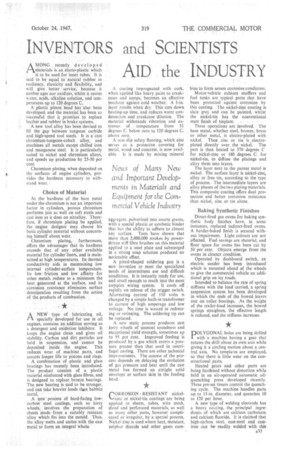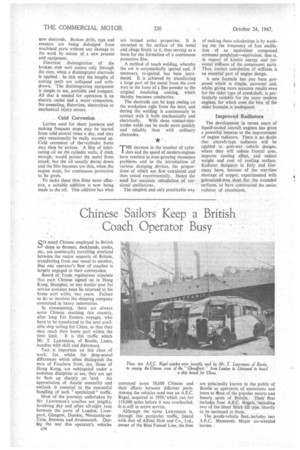AID the INDUSTRY
Page 47

Page 48

If you've noticed an error in this article please click here to report it so we can fix it.
A coating impregnated with cork, whets applied like heavy paint to crankcases and sumps, becomes an effective insulator against cold weather. A I-in. layer results when dry. This cuts down heating-up time, and reduces water condensation and crankcase dilution, The material withstands vibration and extremes of temperature from 51 degrees C. below zero to 120 degrees C. above zero, A non-slip safety flooring, which also serves as a protective covering for metal. wood and concrete, is now available. It is made by mixing mineral aggregate, pulverized into coarse grains, with a special plastic or synthetic binder that has the ability to adhere to almost any surface. Tests have shown that more than 2,000,000 strokes by powerdriven stiff fibre brushes on this material applied to a steel plate and submerged in a strong soap solution produced no noticeable effect.
A pistol-shaped soldering gun is a new invention to meet the specialized needs of intermittent use and difficult conditions. It is instantly ready for use, and small enough to reach into the most complex wiring system. It cools off rapidly on release of the trigger switch. Alternating current of 110 volts is changed by a simple built-in transformer to current of high amperage and low voltage. No time is wasted in redressing or retinning. The soldering tip can be replaced.
A new static process produces cast lorry wheels of unusual soundness and exceptional yield strength, sometimes up to 95 per cent. Improved feeding is produced by a gas which exerts a pressure greater than that used in centrifugal casting. There are other technical improvements. The success of the process depends on delaying the evolution of gas pressure and heat until the cast metal has formed an airtight solid envelope or surface skin in the feeding head,
CORROSION RESISTANT n ick el inc or nickel-tin coatings are being applied to sheets, tubes, wire mesh, diced and perforated materials, as well as many other parts, however complicated or irtegular, by a special process. Nickel-zinc is used where heat, moisture, sulphur dioxide and other gases corn
bine to form severe corrosive conditions.
.Motor-vehicle exhaust. mufflers and fuel, tanks are typical. parts that have been . protected against . corrosion by this coating. ..The nickel-zinc coating is slate grey and can be painted, whilst the, nickel-tin has the conventional matt finish of tinplate; Three operations are involved. The base metal, .whether Steel, bronze, brass or other metal, is electro-plated with nickel. Then zinc or tin is electroplated directly over the nickel. The part is then heated to 370 degrees C for nickel-zinc or 180 degrees C for nickel-tin, to diffuse the plating& and alloy them into layers.
The layer next to the parent metal is nickel. The surface layer is nickel-zinc, alloy or free tin, according to thetype of process. The intermediate layers are alloy phases of the two plating materials. This composite coating offers dual protection and better corrosion resistance than nickel, zinc or .tin alone,
Baking Synthetic Finishes
Direct-fired gas ovens for baking synthetic body finishes have, in some instances, replaced indirect-fired ovens. A harder-baked finish is secured with-out impairment. Light colours are not affected. Fuel savings are material, and floor space for ovens has been Cut by 50 per cent. Objects emerge from the ovens in cleaner condition.
Operated by dashboard switch, an electric sander has been introduced which is mounted ahead of the wheels to give the commercial vehicle an additional grip on icy roads.
Intended to. balance the rate of spring stiffness with the load carried., a spring suspension system. has been developed in which the ends of the bowed. leaves rest on roller .bearings. As the_ weight of the trailer-load increases; the bowed springs straighten, the effective length is reduced, and the stiffness increases.
DOLYGONAL holes are being drilled 1 with a machine having a gear that rotates the drill about its own axis while giving it a circling motion about a central axis. No templates are employed, so that there is little wear on the constructional parts.
Heated gears and other parts are being hardened without distortion while held in an air-operated automatic oilquenching press developed recently. Three pre-set timers control the quenching cycle. The machine handles parts up to 15-in. diameter, and quenches 10 to 120 per hour.
A new type of welding electrode has a heavy coating, the principal ingredients of which are calcium carbonate and calcium fluoride, It is claimed that high-carbon steel, cast-steel and castiron can be' readily welded with this
new electrode. Broken drills, taps and reamers are being dislodged from machined parts without any damage to the work by means of a new process , arid equipment.
Electrical disintegration of the broken. stub tool • occurs only through the core, when a disintegrator electrode is applied. In _this way the lengths of cutting teeth are collapsed and withdrawn. 'The distintegrating equipment is simple to use, portable and compact. All that is needed for operation is an electric outlet and a water connection. NO-annealing, distortion, electrolysis or mechanical injury occurs.
Cold Corrosion
Lorries used for short journeys and making frequent stops may be started from cold several times a day, and may only occasionally be really warmed up. Cold corrosion of the•cylinder bores may then be serious. A film of lubricating oil on the cylinder walls, if thick enough, would protect the metal from attack, but the oil usually drains down and the film becomes too thin, when the engine 'stops, for continuous protection to begiven.
To make these thin films more effective, a suitable addition is now being made to the oil. This additive has what are termed polar properties. It is attracted • to the surface of the metal and clings firmly to it, thus serving as a basis for the formation of a continuous protective film.
A method of touch welding, whereby the arc is automatically ignited and, if necessary, re-ignited, has beenintroduced. It is achieved by transferring a large part of the metal from the core wire in the form of a fine powder to the original insulating coating, which thereby becomes conductive.
The electrode can be kept resting c,n the workpiece right from the start, and during the welding is continuously in contact with it both mechanically and
electrically. With these contact-electrodes welds can be made more quickly and reliably than with ordinary electrodes.
THE increase in the number of cylinders and the speed of modern engines have resulted in ever-growing resonance problems and in the introduction of various damping "devices, the proportions of which are first calculated .and then tested experimentally. Hence the need for accurate • calculation, of torsional oscillations..
The simplest and, only practicable way of making these calculations is by working ow the frequency of free oscillation of an equivalent compound torsional pendulum—equivalent, that is, in respect of kinetic energy and torsional stiffness of the component parts. Thus, correct calculation of stiffness is an essential part of engine design.
A new formula has just been proposed which is simple, universal and, whilst giving more accurate results even for the older type of crankshaft, is particularly suitable for the more modem engines, for which even the best of the older formulm is inadequate.
improved Radiators
The development in recent years of liquid-cooled aircraft engines has given a powerful impetus to the improvement of engine radiators. There is no doubt that aircraft-type radiators will be applied to post-war vehicle designs, where they will reduce frontal area, improve cooling effect, and -reduce weight and cost of cooling surface. Radiator designers in Italy and Germany have, because of the war-time shortage of copper, experimented with galvanized-iron sheet for the extended surfaces, or have constructed the entire radiator of aluminium.
















































































